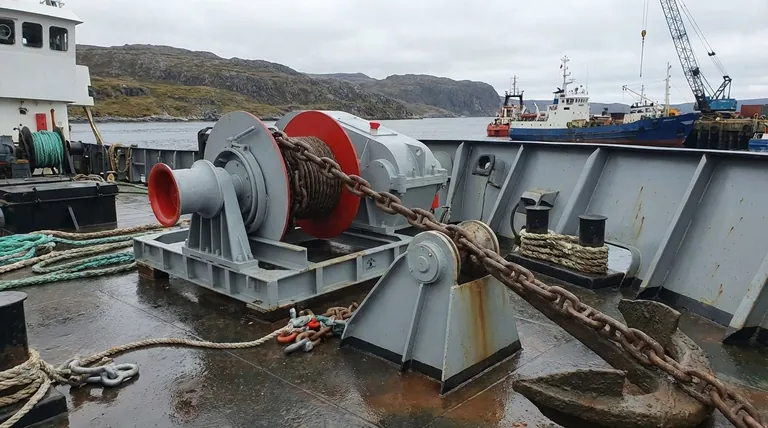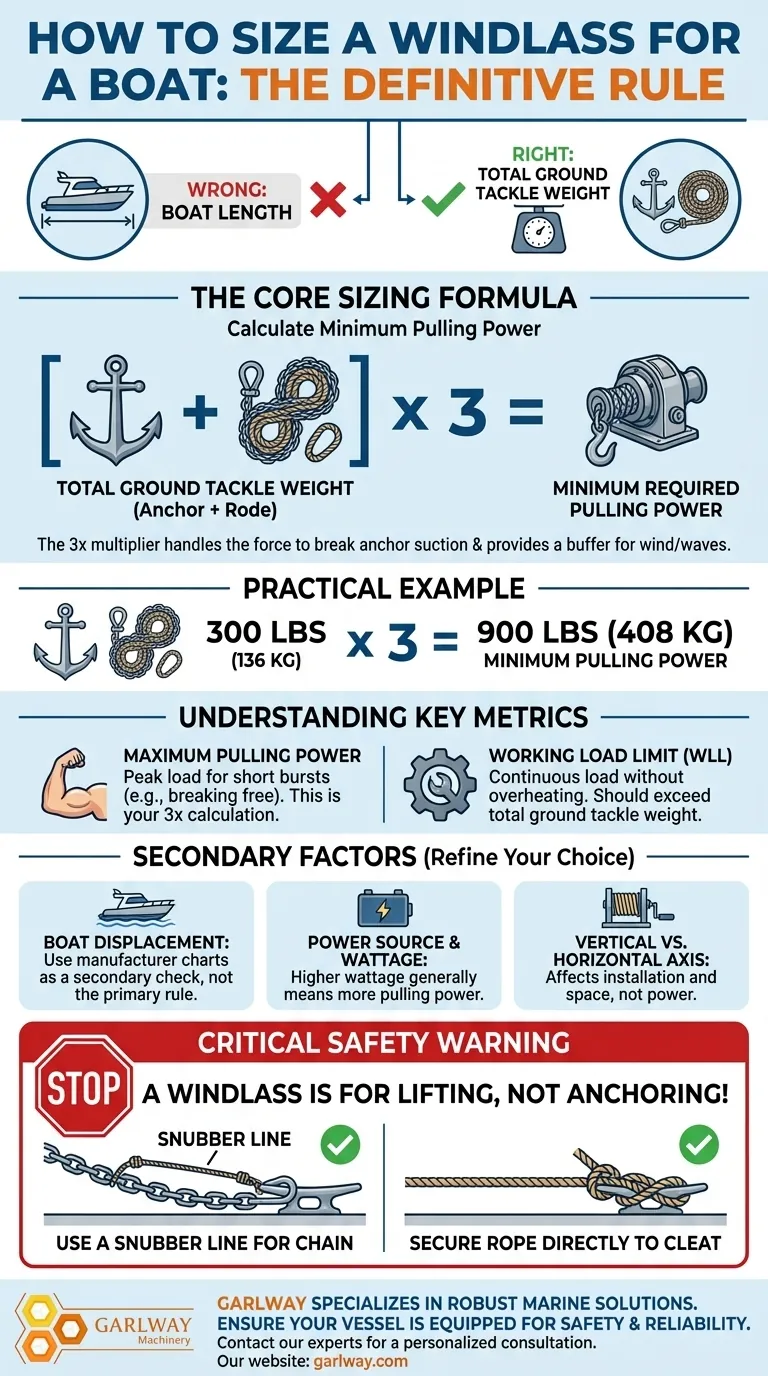The definitive rule for sizing a windlass is based on the total weight of your ground tackle, not the size of your boat. Calculate the combined weight of your anchor and the full length of your chain or rope rode, then multiply that total weight by three. This result gives you the minimum pulling power your windlass must have.
The most common mistake is sizing a windlass to the boat's length. Instead, focus on the real work it has to do: lifting the anchor and rode from the seabed. A simple calculation based on your ground tackle weight provides the necessary safety margin for real-world conditions.

The Core Sizing Formula: Calculating Minimum Pulling Power
The primary function of a windlass is to lift dead weight. The formula ensures it has enough reserve power to handle the added strain of breaking an anchor free from a muddy or rocky bottom, especially in wind or current.
Step 1: Calculate Total Ground Tackle Weight
First, sum the weight of all the components the windlass will lift. This is your "total ground tackle weight."
You must include the anchor itself and the entire length of your chain and/or rope rode that you expect to deploy. Chain is significantly heavier than rope, so an all-chain system requires a more powerful windlass.
Step 2: Apply the "Rule of Three"
The industry-standard calculation is simple yet effective:
Total Ground Tackle Weight x 3 = Minimum Required Pulling Power
This multiplier isn't arbitrary. It accounts for the significant extra force needed to break the anchor's suction from the seabed and provides a buffer for the effects of wind and waves acting on the boat.
A Practical Example
Imagine your ground tackle consists of an anchor and all-chain rode with a combined weight of 300 lbs (136 kg).
Using the formula: 300 lbs x 3 = 900 lbs.
Your windlass must have a minimum pulling power (often called "maximum load" or "max pull") of at least 900 lbs (408 kg).
Beyond the Formula: Factors That Refine Your Choice
While the 3x rule is your foundation, other factors help you confirm you're making the right choice for your specific vessel and needs.
Boat Size and Displacement
Manufacturers often provide charts that suggest windlass models based on boat length. Use these as a secondary check or a starting point, but do not let them overrule the 3x calculation based on your actual ground tackle. A 40-foot lightweight boat may need a smaller windlass than a heavier 35-foot boat with an oversized anchor.
Power Source and Motor Wattage
For most recreational vessels, a 12V or 24V electric windlass is standard. The power in watts (e.g., 700-1000 watts for a 10-meter boat) is another indicator of its strength. A higher wattage generally corresponds to greater pulling power and durability.
Vertical vs. Horizontal Axis
The orientation does not directly impact the required power, but it does affect installation. Vertical windlasses have a lower profile on deck but require more space in the chain locker below. Horizontal windlasses are mounted entirely on the deck, making them simpler to install where locker space is tight.
Understanding the Trade-offs and Common Pitfalls
Choosing the right size is only part of ensuring a reliable anchoring system. You must also understand its operational limits and proper use.
Maximum Pull vs. Working Load
Be aware of two key specifications. Maximum Pulling Power is the peak load the windlass can handle for a short period, such as when breaking the anchor free. This is the number you derive from the 3x rule.
Working Load Limit (WLL) is the continuous load the windlass can handle without overheating. Some manufacturers, like Lofrans, suggest your total ground tackle weight should not exceed the WLL. A higher WLL indicates a more robust, durable unit.
The Danger of Undersizing
An undersized windlass is a serious liability. It can lead to tripped circuit breakers, a burnt-out electric motor, or a complete failure to retrieve your anchor—potentially in a dangerous situation where you need to move quickly.
CRITICAL: A Windlass is for Lifting, Not Anchoring
Never allow the windlass to bear the full load of the boat at anchor. The shock loads from wind and waves can easily damage the gearbox, main shaft, and other internal components.
For all-chain rode, you must use a snubber line with a chain hook to transfer the load from the windlass to a strong deck cleat. If you use a rope rode, secure the rope directly to a cleat once the anchor is set.
Making the Right Choice for Your Goal
Use your calculated pulling power and anchoring style to select the best unit for your needs.
- If your primary focus is coastal cruising in fair weather: A windlass that correctly meets the 3x minimum rule will provide safe and reliable service.
- If your primary focus is offshore passage-making or anchoring in demanding conditions: Select a windlass with a pulling power that exceeds the 3x minimum and has a higher working load limit for maximum durability and peace of mind.
- If you are retrofitting an older boat: Double-check your boat's electrical system to ensure it can handle the high amperage draw of the windlass motor you select.
Sizing your windlass correctly is the foundation of a safe and stress-free anchoring system.
Summary Table:
| Key Factor | Description | Calculation/Example |
|---|---|---|
| Core Formula | Minimum pulling power based on total ground tackle weight. | Total Weight x 3 = Min. Pulling Power |
| Total Ground Tackle Weight | Combined weight of anchor and full length of chain/rope rode. | e.g., Anchor + 300 ft of chain = 300 lbs |
| Minimum Pulling Power | The peak load needed to break the anchor free. | 300 lbs x 3 = 900 lbs minimum |
| Working Load Limit (WLL) | The continuous load the windlass can handle safely. | Should be greater than total ground tackle weight. |
Ensure Your Vessel is Equipped for Safety and Reliability
A correctly sized windlass is critical for stress-free and secure anchoring. GARLWAY specializes in robust marine and construction solutions, offering durable equipment designed for demanding environments. Whether you're a commercial operator or a serious recreational boater, our expertise ensures you get a system built for performance and longevity.
Let us help you select the right equipment for your needs. Contact our experts today for a personalized consultation on reliable marine gear.
Visual Guide

Related Products
- Heavy Duty Electric Boat Winch Windlass Anchor
- Warn Winch Windlass Boat Trailer Winch
- Electric Hoist Winch Boat Anchor Windlass for Marine Applications
- Ready Mixer Machine for Construction Ready Mix Machinery
- Portable Cement Mixer with Lift Concrete Machine
People Also Ask
- What is the general user satisfaction with boat anchor winches? A Game-Changer for Boaters
- How do electric boat winches work? Unlock Effortless Launching & Retrieval
- How much current does an electric boat winch draw? Plan Your Electrical System for Peak Performance
- What are some challenges with windlass type winches? Key Issues in Rode Matching and Operation
- What are marine electric winches and their characteristics? Key Features for Reliable Maritime Operations



















